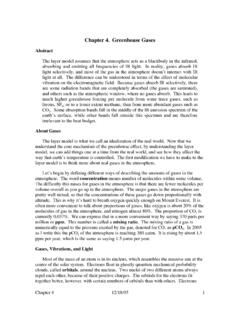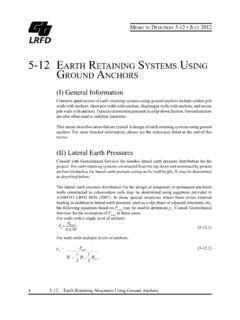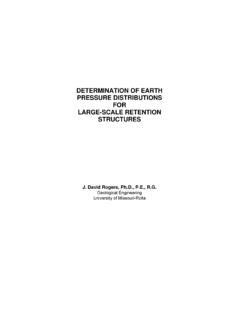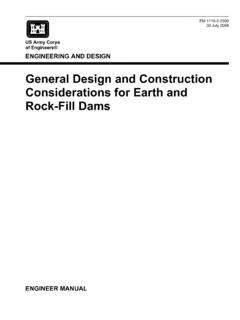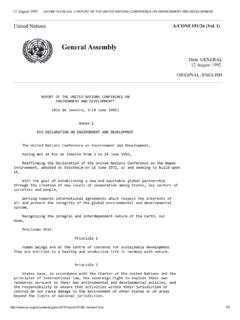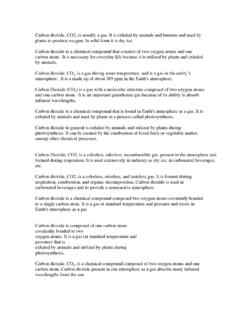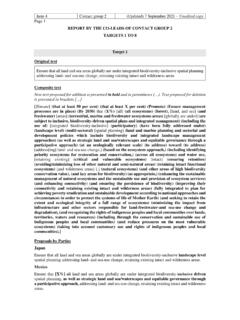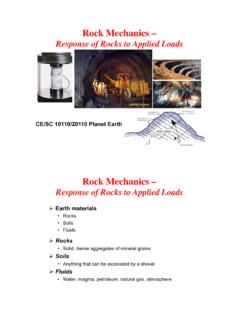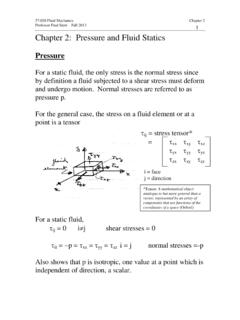Transcription of Greenhouse Gases CHAPTER 4 - University of Chicago
1 Greenhouse Gases CHAPTER 4. Why some Gases are Greenhouse Gases , but most aren't, and some are stronger than others About Gases The layer model is what is called an idealization of the real world. It has the essential ingre- dient of the Greenhouse effect, but it is missing numerous things that are important in the real atmosphere. Starting from the Layer Model, the next few chapters add things one at a time, assembling the rest of the ingredients that control the temperature of the real Earth. The first task is to understand how real Gases interact with infrared (IR) light in the real atmosphere. Let us begin by defining different ways of describing the amounts of Gases in the atmo- sphere.
2 The word concentration means the number of molecules within some volume. The difficulty this raises for Gases in the atmosphere is that the concentration, defined in this way, changes as the gas expands or contracts. It is often more convenient to talk about proportions of Gases ; for example, oxygen is about 20% of the molecules of gas in the atmosphere, and nitro- gen is almost 80%. The proportion of CO2 is currently We can express that in a more mnemonic way by saying 390 parts per million, or ppm. This number is called a mixing ratio. A gas exerts pressure, a pushing force, on itself or on the surface of anything in contact with it.
3 The force comes from deflected momentum of gas molecules bouncing off the surface. The pressure of a mixture of Gases can be taken apart into what are called partial pressures arising from each type of molecule in the gas, which add up to the total pressure. The partial pressure of CO2 , for example, is written as pCO2 . One might expect heavier Gases to contribute disproportionately to the pressure because they seem like they would hit the walls harder. It works out, however, that heavier gas molecules are moving more slowly than the light ones are, just enough so that the pushing force, propor- tional to the mass times the velocity, is the same on average with every type of molecule regardless of how heavy it is.
4 It is as if a bunch of ping-pong balls and bowling balls rolled against the wall all pushed equally on the wall. They are equal because you have to roll the bowling balls more slowly. At a given temperature, each molecule has the same amount of energy on average invested in motion, what is called kinetic energy. A heavy molecule will move more slowly with its allotment of kinetic energy. A gas pressure, in units of microatmospheres ( atm), is numerically nearly equal to its mixing ratio in parts per million (ppm). The bottom line is that the partial pressure from a gas is more or less proportional to the mixing ratio, the numerical proportion of the gas.
5 If you think in pressure units of atmospheres, the actual numbers are the same for the partial pressure and the mixing ratio. For CO2 , for example, the mixing ratio is currently about 390 ppm, and its pCO2 is about 390 atm. 29. 30 CHAPTER 4 Greenhouse Gases Gases , Vibrations, and Light Most of the mass of an atom is in its nucleus, which resembles conceptually a massive sun at the center of a solar system. Two nuclei of two different atoms always repel each other because of their positive charges. Electrons float in ghostly quantum mechanical probability clouds, called orbitals, around the nucleus. For some combinations of atoms, the electrons fall into orbitals that are shared between the two nuclei.
6 These electrons are the glue that holds together a chemical bond between the atoms. A chemical bond is like a spring in that the two nuclei on either end of the bond have some freedom to move closer or farther apart. There is an optimum, lowest-energy distance for the nuclei to be from each other. If they are any closer, the positive nuclei will start to repel each other. Farther from each other, you get less energy gain from sharing the electrons. A. bond vibrates when the distance between the nuclei oscillates between the nuclei being too close together, then too far apart. This is called a stretching vibration.
7 An atom may participate in more than one chemical bond. The bonds, and extra electrons that the central atom holds on to, arrange themselves around the atom to find their positions and angles of least energy. Here again there is some flexibility in the angle of the bond, which leads to a bending vibration. Chemical bonds vibrate at particular frequencies. Molecular vibrations in gas molecules are like vibrations of a piano string in that they tend to be at specific ringing frequencies. For weights and springs, the vibrational frequencies depend on two things: the mass of the weights and the springiness of the spring holding them together.
8 Imagine the weights moving together, nearing the optimal distance but with enough momentum to carry them closer than they would like to be, continuing the oscillation. Heavier weights would have enough inertia to keep moving closer for a longer time than would a lighter pair of weights, so the frequency of the vibration will be slower with heavy weights. If the spring is very stiff, it will reverse the velocity of a vibration more quickly, and the frequency of the oscillation will be higher. Vibrations in chemical bonds depend on the mass of the nuclei and on the energy penalty for stretching or bending the bond, which determines the springiness of the chemical bond.
9 Most forms of liquid and solid molecules are not so choosy about frequency of IR light that they can absorb or emit, because the molecules interact with each other so much that more or less all frequencies of IR light can be absorbed and emitted. Liquids and solids are pretty good blackbodies, in other words. Gases however only absorb and emit specific frequencies of IR light, meaning that they are generally not very good blackbodies. In fact, most of the Gases in the atmosphere do not absorb or emit IR light at all, because vibrations in their bonds do not create an imbalance in the electrical field. Both O2 and N2 , the most abundant Gases in the atmosphere, are symmetric molecules, made of two identical atoms whose electric fields just cancel each other out.
10 Neither atom can hold the electrons any more tightly than the other, so there is no difference between the electrical field on one side of the molecule versus the other. The symmetry is unbroken when you stretch or compress the bond. Symmetrical molecules with only two atoms are never Greenhouse Gases . To create or absorb infrared light, the molecule must be electrically lopsided, at least in passing. Gases , Vibrations, and Light 31. If the symmetry is broken by having different types of atoms on each side, like carbon monoxide (CO) or nitrogen oxide (NO), the molecules begin to have some Greenhouse properties.
